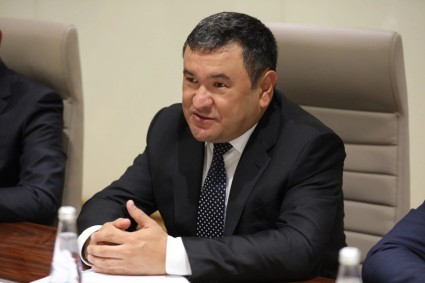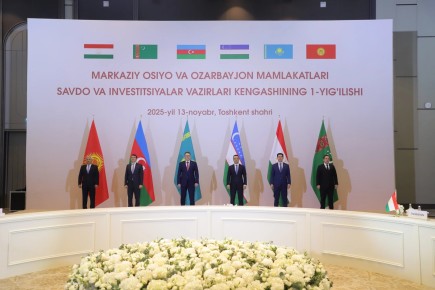On May 31, 2024, S&P Global Ratings affirmed its 'BB-/B' long- and short-term foreign and local currency sovereign credit ratings on Uzbekistan. The outlook is stable.
The transfer and convertibility (T&C) assessment remains 'BB-'.
Outlook
The stable outlook considers Uzbekistan's favorable growth prospects over the next 12 months and risks from increasing external and net general government debt, albeit from moderate levels.
Downside scenario
We could lower the ratings if external and government debt continue to increase rapidly, raising fiscal and balance of payments risks, especially if the anticipated benefits from related projects do not materialize as planned.
Upside scenario
We could raise the ratings if reforms lead to stronger-than-expected medium-term growth potential, with positive spillover effects for the fiscal and external positions.
Rationale
Uzbekistan has started a second phase of reforms as part of its economic modernization agenda that began in 2017. To address issues regarding energy security, the high fiscal cost of subsidies, and rising gas imports, the government has raised electricity and gas tariffs since October 2023 after several years of delays. Authorities are also working with international financial institutions and foreign investors, largely from the Middle East and China, to attract and finance investment into electricity generation, green energy, gas production, and mining. We expect these reforms, along with a renewed push for more market-friendly policies, will drive strong annual growth exceeding 5% on average through 2027.
However, sizable investments under the development plans are driving up Uzbekistan's net general government and external debt. Following a record high current account deficit of 8.6% of GDP in 2023, we forecast still-elevated deficits of 7.6% of GDP annually on average over 2024-2027, given continued import growth. Positively, Uzbekistan's net general government debt remains moderate in a global comparison--we anticipate it will reach 31.7% of GDP by the end of 2024.
Overall, our ratings on Uzbekistan are supported by the economy's still-moderate external debt and total government debt. The sovereign's fiscal and external stock positions have historically benefited from the policy of transferring some revenue from commodity sales to the sovereign wealth fund, the Uzbekistan Fund for Reconstruction and Development (UFRD).
Our ratings are constrained by Uzbekistan's low economic wealth, measured by GDP per capita, and low--albeit improving--monetary policy flexibility. In our view, policy responses are difficult to predict, given the highly centralized decision-making process and less developed accountability and checks and balances between institutions.
Institutional and economic profile: Growth momentum will remain strong, notwithstanding significant external risks
- We forecast that economic growth will average 5.2% over 2024-2027, slightly below the 6.0% of 2023.
- Economic and governance reforms, including planned hikes to energy tariffs, will support the country's investment prospects.
- Decision-making will remain centralized and the perception of corruption high, although improving, in our view.
From 2021-2023, Uzbekistan saw high real GDP growth of about 6.4% on average annually, and we expect prospects to remain strong, supported by public and private investment. Uzbekistan's growth is heavily investment led, with one of the highest investment-to-GDP ratios globally, at about 43% last year. Under the "Uzbekistan-2030" strategy, the government and public entities are fueling investments in the energy, transport, telecommunications, agriculture, and tourism sectors, while moving ahead with energy sector reforms, privatizations, and improving fiscal policy.
After several years of delays, the government introduced higher electricity and gas tariffs for businesses in October 2023, expanding those to households in May 2024. They aim to almost reach cost recovery by 2027. The government also plans to diversify and modernize the generation of electricity, particularly green energy, mainly through public-private partnerships (PPPs). For instance, Saudi Arabia's ACWA Power is investing heavily in Uzbekistan to install 5,000 megawatts (MW) of electricity, with a country target to achieve 25,000 MW of renewable energy by 2030. Uzbekistan is also expanding production of copper, gold, silver, and uranium to boost the export base.
Despite the increasing energy tariffs and high interest rates, we consider that government stimulus measures, such as value-added tax refunds and regulated prices on several consumer goods, should maintain consumption growth. However, to reduce the high import growth, authorities removed import tax exemptions on cars and almost 40 essential food items introduced in 2023.
Uzbekistan's economy continues to weather the spillover effects from the Russia-Ukraine war reasonably well, even as remittance inflows and money transfers from Russia decrease from the highs of 2022. Remittance inflows declined one-third in 2023 to about $11 billion (11% of GDP), but were still about 40% higher than in 2021, and increased 9% year on year in first-quarter 2024. Russia remains Uzbekistan's largest remittance source, at 78% of total remittances in 2023. In addition, total trade with Russia increased about 16% in first-quarter 2024 from the same period in 2023. Given Western-alliance-led sanctions on Russia, Uzbekistan's exports to Russia have increased to meet increasing demand. In addition, Uzbekistan signed a two-year deal with Russia's Gazprom in October 2023 to import 9 million cubic meters of gas per day.
In our view, the risk of secondary U.S. and EU sanctions on Uzbek companies doing business with Russia remains, although the government tries to comply with sanction requirements. For example, the U.S. and EU have sanctioned several Uzbek companies involved in trading electronic and telecommunications equipment and goods in the defense industry. In response, the government is implementing enhanced diligence processes, automated screening measures, and stress testing.
Despite strong growth, our sovereign ratings on Uzbekistan are constrained by low GDP per capita when compared globally, at a projected $2,600 in 2024. The country benefits from favorable demographics, given a young population; almost 90% are at or below working age, which presents an opportunity for labor-supply-led growth. However, it will remain challenging for job growth to match demand, in our view. Weakness in the Russian economy, where most of Uzbekistan's permanent and seasonal expatriates are employed, could further exacerbate this issue.
A new constitution adopted in May 2023 lengthened the presidential term limit to seven years from five and allows the current president to remain in power until 2037. The incumbent president, Shavkat Mirziyoyev, won the election held July 9, 2023, that followed the constitutional referendum. He secured 87% of the votes. International observers noted a lack of competition in the election. In our view, government policy responses can be difficult to predict in Uzbekistan, considering the centralized decision-making process and limited checks and balances between institutions, despite reforms. Significant uncertainty over future succession remains.
Flexibility and performance profile: Government and external debt continue to rise
- We expect net general government debt will reach 38% of GDP by 2027, compared to a net asset position in 2017.
- We forecast Uzbekistan's current account deficits will average 7.6% of GDP through 2027, funded primarily through concessional external debt and net foreign direct investment (FDI) to a smaller extent.
- Despite improvements in monetary policy in recent years, we still view the central bank's operational independence as constrained, and loan dollarization remains elevated at over 40%.
To mitigate the fallout from the Russia-Ukraine war and high food prices in recent years, the government increased social spending and wages in 2023. The fiscal deficit increased to 5.5% of GDP, significantly higher than the budgeted 3.0%. From 2024, we expect gradual fiscal consolidation on the back of subsidy reforms, better-targeted social spending, and the removal of some tax exemptions. Authorities estimate savings of about 1 percentage point of GDP this year from higher energy and gas tariffs. As the government works to reduce the gray economy and improve operations at government-related entities (GREs), we expect the tax base will gradually increase.
The government expects the fiscal deficit to drop to 4% of GDP in 2024 and 3% in 2025. We expect fiscal consolidation to be slightly slower, with the deficit projected to reach 3.2% of GDP by 2027. Additionally, risks to our projections include potentially higher expenditure on social protection and the reliance on the sale of commodities, such as gold, the prices of which can be volatile. Social spending, including wages, makes up about 50% of government expenditure and can be difficult to adjust for political reasons.
We expect gross government and government-guaranteed debt will increase to about 46% of GDP in 2027 from 40% in 2023. We include government-guaranteed debt in general government debt because of the close links with GREs. The state debt law approved by the president in April sets a permanent debt ceiling at 60% of GDP, and the application of corrective measures if it breaches 50%. There are also limits on annual borrowing, PPP debt levels, and state guarantees. The state is allowed to borrow external debt of up to $5 billion in 2024.
We think there is some risk that nonguaranteed GRE and PPP debt, totaling about 8% of GDP in 2023, could crystallize on the government's balance sheet. GREs have significantly increased borrowings in recent years, particularly in foreign currency, to finance energy and infrastructure projects. In our view, they could face issues in repaying this debt if some projects fare worse than expected, or if there are lapses in management or supervision.
To reduce exposure to fluctuations in currency movements and build domestic capital markets, the government is increasing domestic borrowing. The proportion of domestic debt to total debt stood at 17% as of March 31, 2024, up from 11% at year-end 2022. The government recently issued U.S.-dollar-denominated Eurobonds in May 2024 of $600 million, euro-denominated Eurobonds of €600 million ($652 million), and bonds worth Uzbek sum (UZS) 3 trillion (about $236 million). The government paid 16.63% for UZS-denominated bonds for three years, with repayments in U.S. dollars. As the proportion of domestic and commercial debt increases, we expect borrowing costs will also rise, but from a low base. About 90% of external debt is on concessional terms.
The government's liquid assets, at 13% of GDP in 2023, is down from 37% in 2017. They mostly include assets of the UFRD, which was founded in 2006 and initially funded with capital injections from the government; and revenue from gold, copper, and gas sales above certain cutoff prices until 2019. We include only the external portion of UFRD's assets in our calculation of government liquid assets because we view the domestic portion, which consists of loans to GREs and capital injections to banks, as largely illiquid and unlikely to be available for debt-servicing if needed. The UFRD's assets totaled $16.8 billion as of March 31, 2024, with the liquid portion at $6.2 billion.
High current account deficits and increasing external debt could ultimately raise balance of payment risks for Uzbekistan, in our view. The surge in imports in 2023 was largely due to capital goods, machinery, and transport equipment. Some of those reflect a one-off increase such as aircrafts for new domestic airline companies and cars, including electric vehicles, due to temporary import tax exemptions. However, import growth is likely to stay strong because of a large pipeline of investment projects. In addition, Uzbekistan became a net importer of gas in October 2023 after it started importing Russian gas via a pipeline through Kazakhstan. Along with increasing household consumption, large projects like the Gas to Liquids Plant, Shurtan Gas Chemical Complex, and Gas Chemical Complex MTO (methanol to olefin) will add to gas consumption and imports over our forecast period.
Mirroring sizable current account deficits, the country's gross external debt has risen in recent years across the government, corporate, and financial sectors. Our external forecasts are based on the expectation of moderating foreign debt accumulation over the forecast horizon. However, FDI inflows remain relatively low and concentrated in the extractive industries. We expect FDI inflows will increase only gradually despite the ambitious pipeline of privatization, partially due to lower investment from Russian companies. Therefore, a significant portion of current account deficit financing will likely still be through debt.
Uzbekistan's exports continue to rely on commodities, which constituted almost 50% of goods exports in 2023, particularly gold (42% of goods exports). Favorable gold prices will boost exports in 2024, but we expect these to decline over our forecast period to $2,000 per ounce (/oz) in 2025 and $1,700/oz in 2026, from $2,100/oz for the rest of 2024 (see "S&P Global Ratings Metal Price Assumptions: Prices Rise On Tight Supply And Higher Costs," published May 2, 2024, on RatingsDirect). Conversely, increasing copper production and prices could offset part of the decline.
We estimate that Uzbekistan's usable foreign exchange reserves will decline through 2027 due to an expected fall in gold prices and ongoing current account deficits. The Central Bank of Uzbekistan's (CBU's) holdings of monetary gold constitutes more than 80% of total usable reserves. The CBU has priority rights to purchase gold mined in Uzbekistan. It purchases the gold with local currency, then sells U.S. dollars in the local market to offset the effect of its intervention on the Uzbek sum. We exclude UFRD's assets from the CBU's reserves because we consider the former held primarily for fiscal, rather than monetary or balance of payments, needs. Our view is supported by the budgetary use of external UFRD assets in the domestic economy over the past four years.
Uzbekistan's monetary policy effectiveness has improved in recent years. One of the most significant reforms in that regard was the liberalization of the exchange rate in September 2017 to a managed float from a crawling peg. The CBU intervenes in the foreign exchange market intermittently to smooth volatility and mitigate the increase in local currency via its large gold purchases.
We forecast inflation will reach 11.0% this year, up from a 9.1% average in 2023, given tariff hikes. We expect inflation to fall gradually to 6.5% by 2027. In 2020, the CBU adopted measures to transition to an inflation-targeting mechanism, with a target of 5%.
In our view, the large footprint of state-owned banks in the sector, at 67% of total assets, and preferential government lending programs reduce the effectiveness of the monetary transmission mechanism. Following the privatization of Ipoteka bank in 2023, authorities plan to privatize Asaka and SQB banks. However, we consider this a challenging task that will likely take time. Also, directed lending at preferential rates has diminished gradually, in line with the growth of commercial lending, particularly retail loans. To address very strong growth in consumer loans over the past few years, especially for cars, from 2023 the central bank implemented more stringent lending requirements, including limits for car loan portfolio for banks and tighter debt service-to-income limits for retail borrowers.
Dollarization, although declining, remains high at about 43% of loans and 30% of deposits as of March 31, 2024.
In our view, Uzbekistan's banking sector will continue to show resilience. We consider that favorable economic growth prospects, strengthening disposable income, and low penetration of retail lending in Uzbekistan (with household debt below 10% of GDP) will remain among the key factors contributing to strong lending demand in the next few years. The funding profiles of Uzbek banks are largely stable, supported by sizable funding from the state and international financial institutions and growth in corporate and retail deposits. At the same time, access to long-term funding remains scarce in the domestic market. We continue to see bank regulation in Uzbekistan as reactive rather than proactive, with regulatory actions not always predictable and transparent. However, regulation is gradually improving.











